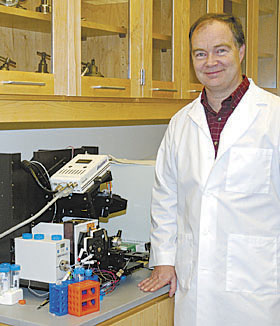For more archives, go to the Advance Archive/Search Page.
Biologist Studying Protein That
Regulates Immune Response
 |
|
MIchael Lynes, professor of molecular and cell biology, with equipment used to measure hundres of molecular interactions simultaneously. |
|
Photo by Dollie Harvey
|
An unusual protein with a tongue-twisting name and dramatic implications for the body’s immune system has captured the attention of Michael Lynes.
Lynes, a professor of molecular and cell biology, is looking for insights into the workings of metallothionein, known as MT, which is produced by cells under stress. Discovered in 1957, it plays a role in detoxifying the body after exposure to heavy metals such as mercury or cadmium, binding to the metal so that it doesn’t damage a cell’s DNA or other important structures.
MT also serves as the predominant protein antioxidant, Lynes says – it can scavenge for reactive oxygen molecules that can damage cells.
But its role in regulating the body’s immune response is of most interest to Lynes. MT can suppress the body’s immune response, something that can be either bad or good – bad if it suppresses the immune response when someone is exposed to biological stresses resulting from cigarette smoke or contaminated water, for instance. Yet MT also has been found to moderate the severity of diseases such as rheumatoid arthritis, an inflammatory, autoimmune disease, in which the immune system goes awry and attacks rather than protects the body.
Interest in MT has grown exponentially over the years, Lynes says. Dozens of laboratories around the country are studying or using it. Lynes is on the scientific advisory board of an international MT conference that will take place next year in Beijing.
Collaborative Research
Lynes does basic research of his own and collaborates with other research groups
to develop instruments and systems that can be used to extend his studies
of the immune system.
One such collaboration has resulted in a technique that Lynes developed with David A. Knecht, professor of molecular and cell biology, to monitor the movement of inflammatory cells. This technique uses instrumentation known as Electric Cell Impedance Sensor (ECIS) marketed by Applied Biophysics Inc., that determines the direction and speed of migrating cells, which can be computed from their arrival time at a target electrode.
The technique was recently patented and licensed and is being tested by a Connecticut drug company. One of its primary uses, Lynes has suggested, will be to study both normal and diseased immune processes, including chronic inflammation, autoimmune disease, and cancer.
Influencing Cell Movement
The study of cellular movement has led Lynes and Knecht to uncover a novel aspect
of the MT protein. Work in their laboratories has shown that the MT protein
can influence cell movement, potentially guiding cells to tissues that have been
wounded or have experienced stressful conditions.
MT has structural features that are shared with chemokines, a class of proteins that cause cells to move in a specific direction, rather than randomly. In inflammation, immune cells move toward a chemokine signal they recognize, which directs them to the site of the injury. If you injure your finger, Lynes explains, it swells and gets red and painful – signs that the immune cells have moved toward the injury to start the healing process.
It may be that excess MT suppresses the immune response by misdirecting the immune cells, sending them to the wrong place, Lynes says. Some forms of cancer make MT, and the immune changes seen in cancer patients may reflect making too much MT or having it in the wrong place at the wrong time, he says.
We all produce MT – too much or too little is bad. By manipulating the amount, it is possible to change the body’s immune response.
“We don’t know the ideal level of MT yet. We’re looking at what tissues MT is made in and how much is made when cells are experiencing different levels of stress,” he says.
The National Institutes of Health, which support most of the research in Lynes’s group, are interested in these immune analyses, such as how toxins affect the immune response.
Wide-Ranging Potential
Lynes’s research on MT has also resulted in collaboration with Ciencia Inc.,
a biotech company in East Hartford.
A system under development at Ciencia called GCSPRI (grating-coupled surface plasmon resonance imaging) can produce real-time, simultaneous measurement of hundreds of molecular interactions in a “label-free” environment – one that does not require a fluorescent tag or radioactivity. At the heart of the system is a microchip developed by Ciencia.
Lynes and his group have developed ways of using the system in their basic biological research, and both NASA and the National Science Foundation have funded his projects with GCSPRI. NASA is interested in the potential for using the compact, lightweight technology at the international space station, and Lynes’s NSF project has used the technology to measure environmental pathogens in the air and water.
Lynes, who is director of graduate programs for the Department of Molecular
and Cell Biology, has a range of researchers working on his projects, from postdoctoral
fellows and graduate students to University Scholars
and undergraduate honors students. Collaborating with biotech companies expands
their network of contacts beyond academia, he notes, providing a different perspective
on basic research activities.

